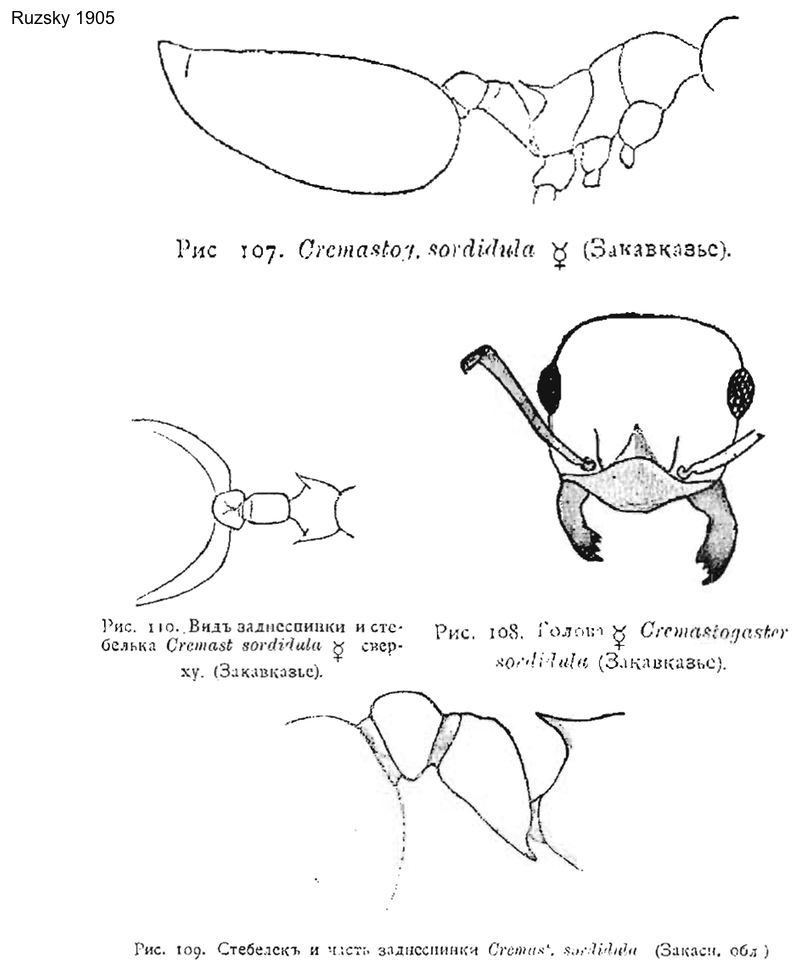Crematogaster bogojawlenskii Ruzsky
 Iran list Iran list Type location Uzbekistan
(Cremastogaster sordidula
bogojawlenskii nov. sbsp., Ruzsky, 1905b: 506, worker &
male) Eastern Bujhara, 14.vi.1898, N B Bogojavlenskiy; no type images
on Antweb (August 2017). Type location Uzbekistan
(Cremastogaster sordidula
bogojawlenskii nov. sbsp., Ruzsky, 1905b: 506, worker &
male) Eastern Bujhara, 14.vi.1898, N B Bogojavlenskiy; no type images
on Antweb (August 2017).
Raised to species: Dlussky, Soyunov & Zabelin, 1990:
243. Junior synonym of Crematogaster
sordidula: Atanassov & Dlussky, 1992: 182 (no pdf available).
Revived from synonymy, revived status as species and senior synonym of Crematogaster kosti (Cremastogater sordidula (Nyl.) var.
kosti, nov. var.
Ruzsky, 1905: 506,
Arakelian, 1994: 44) - no images on Antweb (August 2017).
|
 Ruzsky's
(1905b) description is at Ruzsky's
(1905b) description is at  . Ruzsky's (1905b) illustrated (right)
description of Cr. sordidula with kosti and flachi
is at . Ruzsky's (1905b) illustrated (right)
description of Cr. sordidula with kosti and flachi
is at  . .
What I hope is a reasonable translation reads:
75 Cremastogaster
sordidula bogojawlenskii nov. sbsp.
Worker. The colour of the body is light, brownish-yellow with the
occiput, the end of the flagellum, the transverse bands on the segments
of the gaster and the apex of the gaster brown. The constriction
between the middle and posterior alitrunk is very weak. Thin lateral,
keel-shaped medulla of the middle back directly pass to the propodeum
which has a wide base, short, rapidly tapering toward the end, sharp
propodeal spines. The tooth on the underside of the 1st segment of the
pedicel is very small. Gaster thick, convex from below. The whole body
is more subtle and slender in comparison with the type. The distal
hairs are very rare on the alitrunk dorsum, head, scape and legs. Head
is rounder and smaller. Flagellum uniformly and gradually thickens
toward the apex, forming a 2-segmented club. The length is 2.8-3 mm.
Male. The second segment of the pedicel is continuous, without a
transverse furrow, convex from above. The cheeks are thin, narrow, with
2 denticles. Very sparse distal hairs, long on the gaster and short on
the alitrunk and head. Alitrunk with longitudinal lateral rugae. With a
black-brown head and alitrunk, with light yellowish mustache, mandibles
and legs; gaster light brown with dark posterior border of segments.
The veins on the non-coloured wings are largely atrophied. Antennae
with 11 or 12 segments, of the same shape as the type. The length of
2.6 - 2.8 mm.
Location. Eastern Bukhara on the border with the Pamirs. The Darvaz
Ridge, the village of Chil-Dara-Ishtiyon, along the Khingou River (the
headwaters of the Amu-Darya River). Males and females, 14.VI.1898.
(Bogojavlenskiy).
This is a typical mountain form. Makes nests under rocks.
I dedicate it to N.B.Bogojavlenskiy, an assistant professor of zoology
at Moscow University who delivered a very interesting myrmecological
collection from the Pamirs and their Eastern Bukhara.
This race is close to var. osakensis
For. (from Japan), which was also distinguished by a light pale yellow
body with a brownish-yellow crown and a posterior half of the abdomen;
the head of osakensis is less
rounded and more oblong than that of bogojawlenskii.
The type Cremastogaster sordidula
is very close Madagascar view of Cremast.
rasoherinae For., differing mainly by the special form of the
segments of the pedicel (Forel 285, p. 194) and the Australian Cremast. pallidipes Mayr (= Cr. pallipes Mayr 512. p. 120,
516,
p.107), in which the second segment of the pedicel has a longitudinal
groove, as in Cr. scutellaris.
The synonymy of kosti
perhaps is questionable as Ruzsky gave it as a variety sordidula whereas he described bogojawlenskii as a subspecies.
There are no type images of Cr. sordidula on Antweb. Cr.
rasoherinae can be seen at https://www.antweb.org/specimenImages.do?code=casent0101836.
Cr. pallipes
(uniformly yellow-brown) can be seen at https://www.antweb.org/specimen.do?name=casent0919692
|